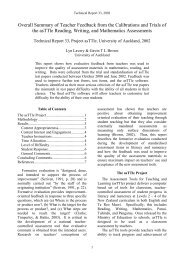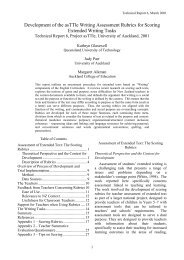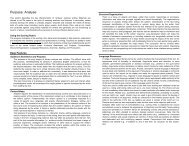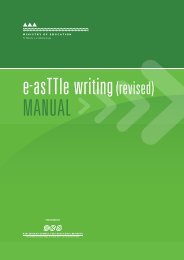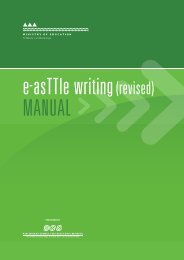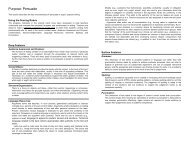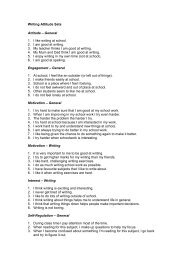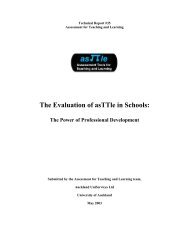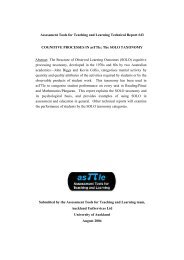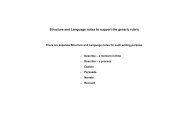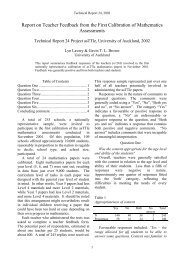11. Maths in the NZ curriculum 2001.pdf - e-asTTle - Te Kete Ipurangi
11. Maths in the NZ curriculum 2001.pdf - e-asTTle - Te Kete Ipurangi
11. Maths in the NZ curriculum 2001.pdf - e-asTTle - Te Kete Ipurangi
Create successful ePaper yourself
Turn your PDF publications into a flip-book with our unique Google optimized e-Paper software.
Know Read / follow Solve<br />
Expla<strong>in</strong> ma<strong>the</strong>matical ideas<br />
Interpret <strong>in</strong>formation and results <strong>in</strong> context<br />
Follow a set of <strong>in</strong>structions for ma<strong>the</strong>matical<br />
activity<br />
Classify objects, numbers, and ideas<br />
Devise and use problem-solv<strong>in</strong>g strategies<br />
Use equipment appropriately<br />
Effectively plan ma<strong>the</strong>matical exploration<br />
F<strong>in</strong>d, and use with justification, a ma<strong>the</strong>matical<br />
model as a problem-solv<strong>in</strong>g strategy<br />
Make conjectures <strong>in</strong> a ma<strong>the</strong>matical context<br />
Use words and symbols to describe and<br />
– evaluate <strong>the</strong> powers of whole numbers<br />
(N L4-2)<br />
– express a fraction as a decimal and vice versa<br />
(N L4-4)<br />
– express a decimal as a percentage and vice<br />
versa (N L4-5)<br />
– express quantities as fractions or percentages<br />
of a whole (N L4-6)<br />
– f<strong>in</strong>d a given fraction or percentage of a<br />
quantity (N L4-9)<br />
– satisfactory algorithms for addition,<br />
subtraction, and multiplication (N L4-10)<br />
– demonstrate knowledge of <strong>the</strong> conventions for<br />
order of operations (N L4-11)<br />
– calculate perimeters of circles, rectangles, and<br />
triangles, areas of rectangles, and volumes of<br />
cuboids from measurements of length (M L4-2)<br />
– make sensible estimates and check <strong>the</strong><br />
reasonableness of answers (N L4-7)<br />
– read a variety of scales, timetables, and charts<br />
(N L4-3)<br />
– <strong>in</strong>terpret graphs on whole number grids which<br />
represent everyday situations (A L4-3)<br />
– evaluate o<strong>the</strong>rs’ <strong>in</strong>terpretations of data<br />
displays (S L4-6)<br />
generalise patterns<br />
– f<strong>in</strong>d fractions equivalent to one given (N L4-3)<br />
– solve problems <strong>in</strong>volv<strong>in</strong>g decimal multiplication<br />
and division (N L4-8)<br />
– perform calculations with time, <strong>in</strong>clud<strong>in</strong>g 24-<br />
hour clock times (M L4-5)<br />
– f<strong>in</strong>d a rule to describe any member of a<br />
number sequence and express it <strong>in</strong> words<br />
(A L4-1)<br />
– use a rule to make predictions (A L4-2)<br />
– f<strong>in</strong>d and justify a word formula which<br />
represents a given practical situation (A L4-4)<br />
– solve simple l<strong>in</strong>ear equations such as<br />
2x + 4 = 16 (A L4-5)<br />
– f<strong>in</strong>d all possible outcomes for a sequence of<br />
events, us<strong>in</strong>g tree diagrams (S L4-9)<br />
– estimate <strong>the</strong> relative frequencies of events and<br />
mark <strong>the</strong>m on a scale (S L4-8)<br />
<strong>Te</strong>chnical Report 11: Mapp<strong>in</strong>g <strong>the</strong> Ma<strong>the</strong>matics Curriculum 23





